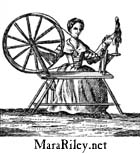|
Pg. 3, paragraph 2 will now read:
Wool, linen, hemp, silk,
and cotton are the fibers that were available in the 18th century.
Reenactors often start out with cotton, but unless you have researched
cotton and its applications, it is easy to make mistakes. There were many
qualities and varieties of cotton available, but in some areas it was
harder to come by than others. The finishes, dye processes and printing
methods and country of origin dictated the cost to the consumer, unless it
were home grown as it was in the south. Basic items like shifts and aprons
that would be worn and washed often were most often made of linen. When
making outer garments most available calico prints aren't right for 18th
century clothing. If you do use cotton for petticoats, jackets or gowns it
is best to concentrate on simple stripes and solids.
Pg. 4, paragraph 1 will now read:
Shopping for linen can be
confusing if you don't know what weights to buy. There are reputable
specialty merchants well versed in the nuances of weight, finish, pattern
and use; the newcomer might do well to seek them out for their advice.
Fabrics up to 4 oz. or so in weight will be appropriate for caps,
handkerchiefs and shifts. Weights of about 6 oz .to 9 oz will work for
petticoats, jackets, and gowns. Heavier weights of 10-12 oz. are
considered more of a canvas weight. An appropriate for stays, work aprons
and some lower class outer garments. Most fabric sellers will send
swatches upon request, sometimes for a modest fee.
Pg. 4, the final sentences of paragraph 3 will now read:
Pure
wool fabric can be hard to find these days, though it is available from
specialty merchants within the hobby. A synthetic content of up to 15%
usually looks enough like 100% wool to be acceptable and still fire
resistant, but you should avoid wool-Lycra blends, as that gives the
fabric a nonperiod look and stretchy feel.
Pg. 5, the paragraph that ends at the top of the page will
read:
Choose simple checks or balanced stripes until you are more
familiar with period textiles, as well as the context in which they were
used. Stripes and checks were usually woven into the fabric, not printed,
unless they were part of a more complex printed design. Cabbage roses,
reproduction 19th c. calicoes, and paisley patterns should be avoided.
Pg. 8-9, shifts:
Researchers Paul Dickfoss and Kate Johnson,
illustrator of this book, tell me that they have 4 or 5 citations between
them for women's shifts being made of wool flannel, and are looking for
more references. Dickfoss's are from a 1761 Dictionary of Trade and a
runaway ad, Johnson's are from original inventories. Men's wool flannel
shirts were not uncommon in New England runaway ads, and like shifts they
were considered undergarments.
Pg. 10, petticoats:
If you do, in fact, make all your
petticoats the same length, the one worn underneath will show under the
uppermost petticoat. This seems to be a reenactorism, since one
doesn't see this in period art. It might be best to have a shorter
petticoat as the one most commonly worn underneath the outer one.
Pg. 15, 'corset blanc':
A friend who speaks more French than
I do suggests that the 'blanc' in 'corset blanc' means 'empty', as in
'unboned', rather than referring to the color of the garment. The entire
discussion is in the archives of the FandIWomen list on Yahoo.
Pg. 26, 'modesty piece':
On p. 230 of An Elegant Art: Fashion
and Fantasy in the Eighteenth Century, the glossary lists the term
'modesty bit' as used in a 1731 article. Nevertheless, the most common
term seems to have been 'handkerchief', even though it was worn around the
neck. Many reenactors refer to it as a 'neckerchief', a lesser-used period
term, because to our modern ears a handkerchief is something one carries
in one's pockets.
Pg. 43, sutlers list:
We neglected to include James Townsend
& Son, Inc., who carry a wide range of goods for reenactors and
rendezvousers. That being said, we can't possibly include every 18th c.
sutler in the book, due to space limitations. As noted, there is also an
excellent list of 18th c. sutlers at www.liming.org/revlist/merchant.html.
Author bio, inside back cover, should read: "Mara Riley is a tailor and
seamstress of 17th, 18th, and 19th century garments, including stays. She
has a B.A. in History from Mary Washington College in Fredericksburg, VA."
|

